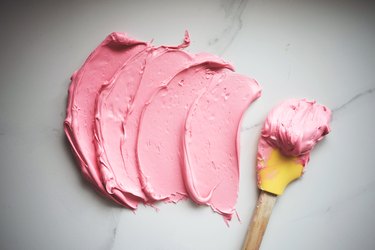
When pink's her favorite color, frosting her birthday cake with any other color simply won't do. The box of food coloring that you pick up at your local grocery store will probably only include four colors (red, yellow, green and blue), so you're going to have to get creative. There are a few ways to fake pink food coloring in your own kitchen.
Making Pink With Food Coloring
Video of the Day
The easiest way to create the appearance that you've used pink food coloring is to add just a drop or two of red coloring to whatever you're making. Fully combine the color and then add just one drop at a time until you've achieved the look you want. For even more control over how much color you add, squeeze the food coloring onto a plate and use a toothpick to swirl in just a tiny bit at a time.
Video of the Day
Because adding too much food coloring will end up turning the final product red, this method is best used with things that are light in color, such as buttercream frosting, milk, sugar cookies or pancakes. With foods that are darker in color, the tint may not be noticeable unless you add enough coloring to turn them red. Also, keep in mind that baked goods tinted with food coloring may not come out with the shade you expected. Light-pink batter may have a subtle pink-brown tint by the time it comes out of the oven.
If you're set on using commercially made food coloring, another option is to search online for pink food coloring. Some companies do sell food-safe color that's formulated to look pink.
Fruits, Veggies and Pink Food Coloring
There are a bunch of benefits to using fruits and vegetables as a natural pink food coloring. For one, this method is certainly preferable for people who are allergic to food dyes, though these allergies are quite rare.
If you're focused on eating clean and using whole ingredients in everything you make, using natural food coloring is a better choice than the store-bought type. Using fruits and veggies to color your food adds sweetness, flavor and maybe even some fiber and nutrients that you just won't get from commercial food coloring.
Making Pink With Beets or Berries
Beets are an ideal source of natural pink food coloring. Using canned beets makes this super simple. In a blender, puree a small amount of the beets with some of their liquid and use the puree to add flavor and pink color to foods. To use fresh beets, cover them with water and simmer them in a saucepan until the beets are tender and the liquid has turned red. Use this liquid as your food coloring.
Pink and red berries can also be used as a source of natural pink food coloring. Freeze-dried strawberries or raspberries are perfect for this purpose. Toss some of these dried berries in a blender or food processor to turn them into powder. Add the powder directly to whatever you're making, or if you're making something smooth and don't want any grainy texture, dissolve the powdered fruit in water before mixing it in.
Note that natural food coloring isn't the best choice for art projects and things that will be displayed. Insects may be attracted to things made with fruits or vegetables.